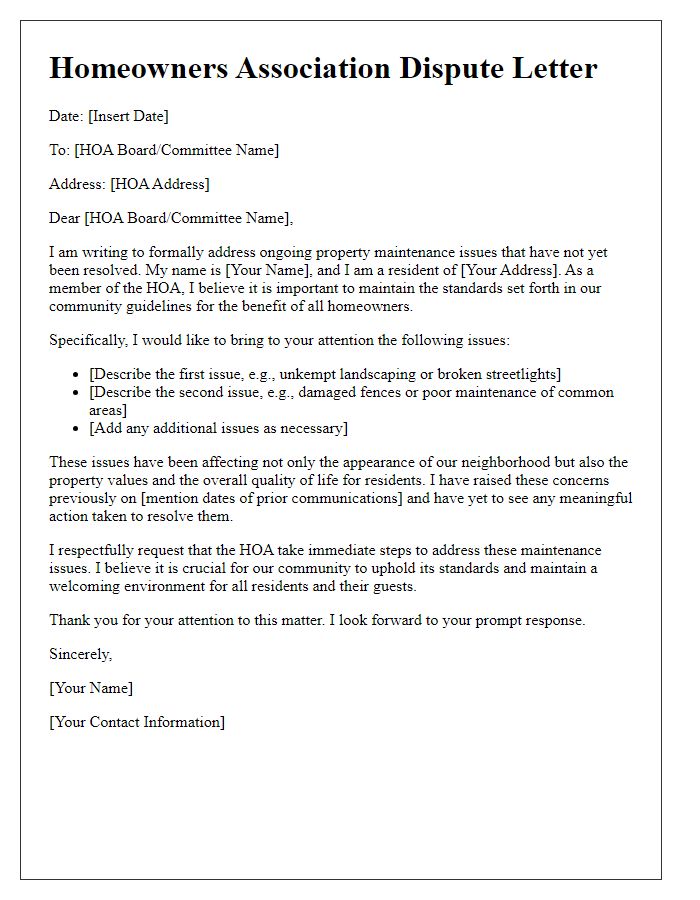Are you feeling overwhelmed by a dispute with your homeowners association? You're not aloneâmany homeowners find themselves in challenging situations when it comes to navigating HOA rules and regulations. Whether it's a disagreement over property maintenance or amenities usage, knowing how to communicate effectively can make all the difference. Join me as we explore key strategies and tips to help you address your HOA disputes with confidence and clarity.

Clarity of Issue
Homeowners associations (HOAs) play a crucial role in maintaining community standards. Clarity in communication is essential to resolve disputes effectively. A clearly documented issue can help streamline the resolution process. Detailed descriptions of the grievance, including dates, specific policies or rules in question, and involved parties, will facilitate a focused discussion. For instance, if a homeowner's fence violates set height regulations, including measurements alongside reference to the HOA bylaws adds context. This structured approach not only expedites negotiation but also fosters understanding among community members, ultimately enhancing neighborhood cohesion.
Specific Regulations/Infringements
Homeowners associations (HOAs) play a crucial role in maintaining community standards through specific regulations, often outlined in governing documents. Common issues include violations of property aesthetics, such as unapproved paint colors or unkempt lawns. For example, an HOA may enforce a guideline stating that all fences must be painted a neutral color; a homeowner painting their fence bright orange could face disputes. Furthermore, regulations may limit the display of personal signage, such as "For Sale" signs, to specific dimensions or styles. Additionally, the HOA may have restrictions regarding the number of pets permitted in a residence which, if disregarded, can lead to formal complaints and penalties. Understanding these specific regulations is vital for homeowners to avoid disputes and ensure compliance within their community.
Supporting Evidence
Homeowners association disputes can often arise from various issues such as property violations, noise complaints, or unauthorized modifications. In many cases, supporting evidence is crucial for presenting a compelling argument. This evidence may include photographs of the disputed area highlighting property maintenance issues, audio recordings documenting noise disturbances during specific hours, or copies of relevant sections from the HOA's governing documents outlining rules and regulations. Additionally, witness statements from other residents who have observed the violation can strengthen the case. Documenting dates and times of incidents, along with any prior communications with the HOA regarding the issue, can provide a chronological framework that illustrates the ongoing nature of the dispute. Accurate and thorough supporting evidence is essential to present a clear view of the situation for resolution.
Proposed Resolution
In homeowner associations, disputes often arise regarding community guidelines or property regulations, necessitating a proposed resolution process. For instance, issues related to noise complaints may escalate when a resident continuously plays loud music during nighttime hours in a neighborhood in Austin, Texas. The proposed resolution involves a formal mediation meeting scheduled at the HOA's community center, designed to facilitate open dialogue between the affected parties and board members. This meeting aims to address grievances and explore mutually agreeable solutions, such as establishing quiet hours from 10 PM to 7 AM or adjusting noise levels during designated times. Documentation of the incident, including dates and descriptions of violations, is essential for a constructive discussion and potential compromise.
Tone and Language
Homeowners Association (HOA) disputes often revolve around issues such as property regulations, dues, or community rules. Clear and respectful communication is essential to resolve conflicts amicably. The tone should remain professional without hostility, fostering an environment conducive to finding solutions. Language choice is crucial; it should be straightforward yet courteous, ensuring that feelings of respect and cooperation are maintained. For example, using phrases like "I appreciate your understanding" or "I am eager to resolve this matter satisfactorily" can help in softening the approach, while clearly stating the concerns and proposed solutions. Keeping the discourse focused on specific facts, dates, and past interactions aids in avoiding misunderstandings. Following these guidelines enables an effective dialogue that can lead to a peaceful resolution.













Comments